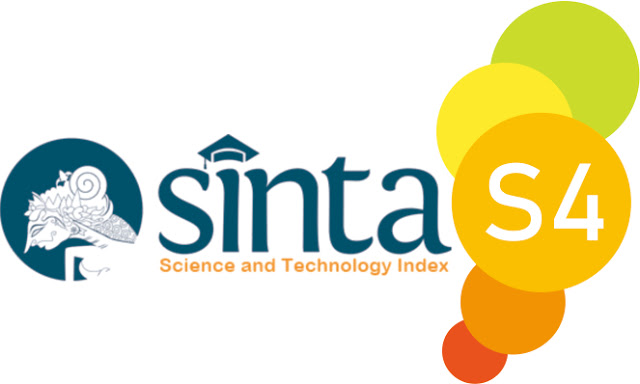Naive Bayes Algorithm Classification for Predicting Graduation Rate
Abstract
Classification refers to the process of identifying a model or function that clarifies or differentiates concepts or categories of data, with the goal of predicting the class of an object. Naïve Bayes is a machine learning technique that employs probability computations. In this case study, various algorithms are used for modeling classification, and the naïve bayes algorithm is applied to examine the graduation rate. By utilizing this method, accuracy is assessed, which allows for an analysis based on criteria such as School Major, First Choice of College, Second Choice of College, Average Graduation Value, and Graduation Information. The outcome of the computation utilizing the Naïve Bayes Algorithm (Information Systems | Option 1) > (Information Engineering | Option 2) is 53.32% > 0%, which allows us to infer that the First Option of Information Systems and the Second Option of Informatics Engineering yield an Average Score of 75.00, resulting in a Graduation Information status of PASS, thus, Information Pass (Option 1-Information Systems).
Downloads
References
Astuti, et al. (2018). Algoritma Naive Bayes Dengan Fitur Seleksi Untuk Mengetahui Hubungan Variabel Nilai Dan Latar Belakang Pendidikan. Jurnal Simetris.
Budi Santosa. (2007), Data Mining : Teknik Pemanfaatan Data untuk Keperluan Bisnis/Studi, 1st ed. Yogyakarta: Graha Ilmu.
Kursini & Emha, T. L. (2009). Algoritma Data Mining.Yogyakarta : Penerbit Andi.
Susana, H. et al. (2022). Penerapan Model Klasifikasi Metode Naive Bayes Terhadap Penggunaan Akses Internet. JURSISTEKNI (Jurnal Sistem Informasi dan Teknologi Informasi), Vol 4, No.1, January 2022: Hal 1– 8 ISSN.
Association Rule. Jurnal Riset Komputer (JURIKOM).
Mulyanto, Agus, 2009, Sistem Informasi Konsep dan Aplikasi, Cetakan I, Pustaka Pelajar, Yogyakarta
Permadi, V. A. (2020). Analisis Sentimen Menggunakan Algritma Naïve Bayes Terhadap Review Restoran Di Singapura. Buana Informatika, Vol.11, No.2:141–151.
Putro, H. F., Vulandari, R. T., & Saptomo, W. L. Y. (2020). Penerapan Metode Naive Bayes Untuk Klasifikasi Pelanggan. Jurnal Teknologi Informasi Dan Komunikasi (Tikomsin), Vol. 8, No.2:19–24.
Supriyatna, Mustika. (2018). Komparasi Algoritma Naive Bayes Dan SVM Untuk Memprediksi Keberhasilan Imunoterapi Pada Penyakit Kutil. Jurnal Sains Komputer & Informatika (J-SAKTI)
Watratan, A., Puspita, A. B., Moeis, D., Informasi, S., & Profesional Makassar, S. (2020). Implementasi Algoritma Naive Bayes Untuk Memprediksi Tingkat Penyebaran Covid-19 Di Indonesia. In Journal of Applied Computer Science and Technology (Jacost), Vol. 1, No 1:7–14.
Uysal, A. K., & Gunal, S. (2014). The Impact of Preprocessing on Text Classification. Information Processing & Management, 50(1), 104-112.
Wu, X., et al. (2008). Top 10 Algorithms in Data Mining. Knowledge and Information Systems, 14(1), 1-37.
Tan, P., Steinbach, M., & Kumar, V. (2005). Introduction to Data Mining. Addison-Wesley.
Han, J., Kamber, M., & Pei, J. (2011). Data Mining: Concepts and Techniques. Morgan Kaufmann.
Aggarwal, C. C. (2015). Data Mining: The Textbook. Springer.
Mitra, S., Pal, S. K., & Mitra, P. (2002). Data Mining in Soft Computing Framework: A Survey. IEEE Transactions on Neural Networks, 13(1), 3-14.
Bayes, T., & Price, R. (1763). An Essay towards Solving a Problem in the Doctrine of Chances. Philosophical Transactions of the Royal Society of London, 53, 370-418.
Quinlan, J. R. (1986). Induction of Decision Trees. Machine Learning, 1(1), 81-106.
Bishop, C. M. (2006). Pattern Recognition and Machine Learning. Springer.
Domingos, P., & Pazzani, M. (1997). On the Optimality of the Simple Bayesian Classifier under Zero-One Loss. Machine Learning, 29(2-3), 103-130.
Cover, T. M., & Hart, P. E. (1967). Nearest Neighbor Pattern Classification. IEEE Transactions on Information Theory, 13(1), 21-27.
Cahyani, L., & Wicaksono, M. (2019). Implementasi Algoritma Naive Bayes Untuk Memprediksi Penyakit Diabetes. Prosiding Seminar Nasional Informatika.
Hastie, T., Tibshirani, R., & Friedman, J. (2009). The Elements of Statistical Learning. Springer.
Russell, S. J., & Norvig, P. (2016). Artificial Intelligence: A Modern Approach. Pearson.
Patel, H., & Prajapati, P. (2018). Study and Analysis of Decision Tree Based Classification Algorithms. International Journal of Computer Sciences and Engineering, 6(10), 74-78.
Copyright (c) 2024 Pradani Ayu Widya Purnama, Nurmaliana Pohan

This work is licensed under a Creative Commons Attribution-ShareAlike 4.0 International License.
This is an open-access article distributed under the terms of the Creative Commons Attribution-ShareAlike 4.0 International License which permits unrestricted use, distribution, and reproduction in any medium. Users are allowed to read, download, copy, distribute, search, or link to full-text articles in this journal without asking by giving appropriate credit, provide a link to the license, and indicate if changes were made. All of the remix, transform, or build upon the material must distribute the contributions under the same license as the original.















